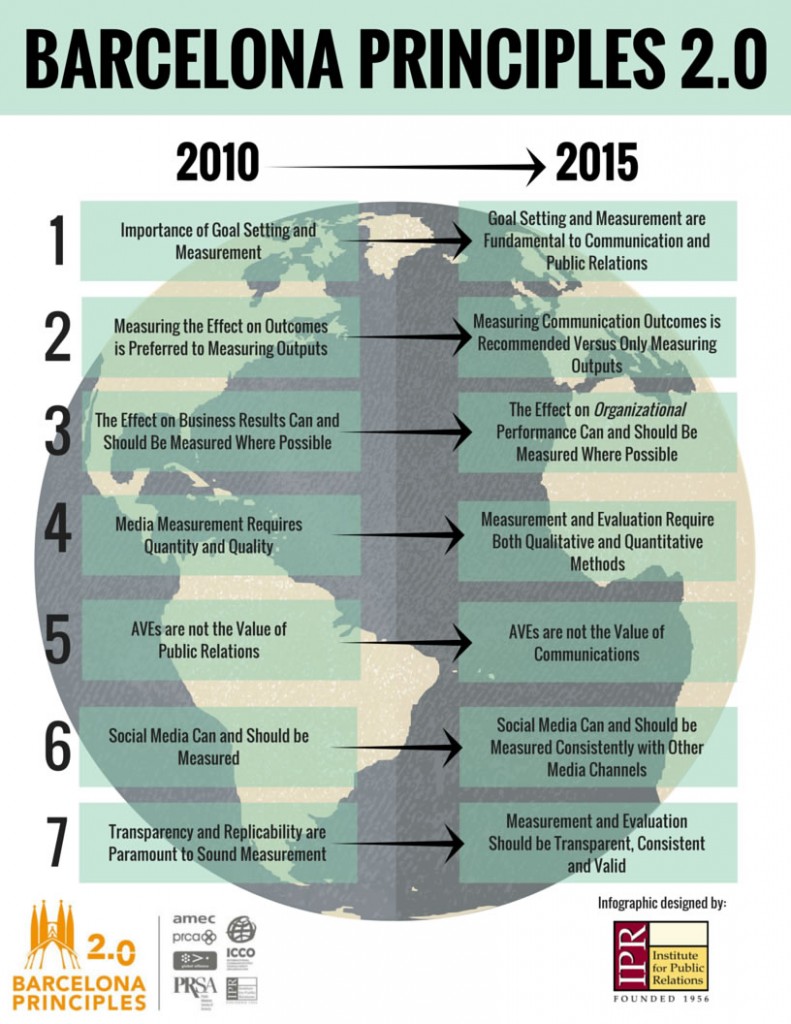On a warm June day in Barcelona in 2010, a group of 150 PR measurement devotees sat together in a hotel conference room and voted on a set of basic principles that defined how to approach measurement. These became known as the Barcelona Principles. I was one of those 150, and five years later was one of about 40 that sat in Ketchum’s London office and heard David Rockland unveil Barcelona Principles 2.0. The update reflected the changing nature of PR, and the Barcelona Principles continue to form the basis of current thinking on PR measurement. Here are the Barcelona Principles in full:
1. Goal Setting and Measurement are Fundamental to Communication and Public Relations
- Conduct measurement and evaluation against defined goals and SMART
- Make goals quantitative or qualitative, but still identify who, what, how much, by when
- Be holistic: traditional and social media; changes in awareness among key stakeholders, comprehension, attitude, and behavior; and impact on organizational results. Campaigns or ongoing are both relevant.
- Be integrated and aligned across paid, earned, shared and owned channels where possible
2. Measuring Communication Outcomes is Recommended Versus Only Measuring Outputs
- Tailor practices for measuring the effect on outcomes to the objectives of the communication program
- Consider both quantitative and qualitative methods
- Apply standard best practices in target audience research
3. The Effect on Organizational Performance Can and Should be Measured Where Possible
- To measure results from communication for an organization, models that determine the effects of the quantity and quality of communication outputs on organizational metrics, while accounting for other variable, are a preferred choice
- Use models that determine the effects of the quantity and quality of communication outputs on organizational metrics
- Develop communication measures that can provide reliable input into integrated marketing and communication models, including through advanced econometrics and advanced survey analysis
4. Measurement and Evaluation Require Both Qualitative and Quantitative Methods
- Consider qualitative methods to better explain the quantitative
- Media measurement, whether in traditional or online channels, should account for:
- Impressions among the stakeholder or target audience
- Quality of the media coverage including, but not limited to:
- Tone
- Credibility and Relevance Message Delivery
- 3rd party or company spokesperson
- Prominence as Relevant to the Medium
- Remember that we are measuring results and progress, not necessarily success
- Quality measures can be negative, positive, or neutral
5. AVEs are not the Value of Communication
- Do not use Advertising Value Equivalents (AVEs)
- Do not use multipliers for “pass-along values’ for earned versus paid media (unless proven to exist)
- If you must make a comparison between the cost of space or time from earned versus paid media, use:
- Negotiated advertising rates relevant to the client
- Quality of the coverage including negative results
- Physical space or time of the coverage related to the portion of the coverage that is relevant
6. Social Media Can and Should be Measured Consistently with Other Media Channels
- Define clear goals and outcomes for social media
- Include measurement methods such as:
- Media content analysis
- Web and search analytics
- Sales and CRM data
- Survey data
- Evaluate the quality and quantity of social media
- Focus measurement on engagement, “conversation” and “communities,” not just “coverage” or vanity metrics such as “likes”
7. Measurement and Evaluation Should be Transparent, Consistent and Valid
- Ensure integrity, honesty, openness and ethical practices
- Use valid methods
- Quantitative = reliable and replicable
- Qualitative = Trustworthy
- Consider other relevant standards, like:
- For Media Measurement: Source of the content along with criteria used for collection; Analysis methodology
- For Primary Research: Methodology; Verbatim questions; Statistical methodology
- Recognize any potential biasing effects in the research itself, or broader societal context
The infographic for the IPR below shows the changes from 2010 to 2015:

